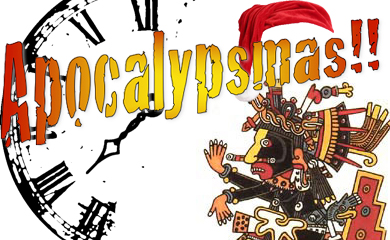
 Welcome to our 10 Day Countdown to the “Apocalypsmas” or the ‘end of time’. Join us each day to learn a little bit about the significance of the Mayan calendar and the date 12/21/2012.
Welcome to our 10 Day Countdown to the “Apocalypsmas” or the ‘end of time’. Join us each day to learn a little bit about the significance of the Mayan calendar and the date 12/21/2012.
First up: An introduction to the Maya calendar from Geneseo’s very own Dr. Jim Aimers (who will be giving a lecture on the Maya collapse at the Toledo Museum of Art in April for the Archaeological Institute of America).
Mesoaamerica is an ancient cultural area which includes parts of Mexico, Belize, Guatemala, Honduras and El Salvador. Mesoamerica was one of seven global “cradles of civilization” in which advanced states developed in part due to the large populations made possible by maize agriculture. Civilizations of ancient Mesoamerica included the Olmecs, the Zapotecs, the Mixtecs, the Aztecs, and the Maya. These socially stratified groups shared cultural characteristics including religions involving animal and human sacrifice, and a ballgame played for religious, political, and recreational reasons.
Another feature shared by Mesoamerican cultures is a sophisticated calendar consisting of two interlocking cycles: a 365 day “solar” cycle that, like ours, follows the course of the solar year and is relevant to all agricultural peoples. The other, specifically Mesoamerican cycle was the 260 year “ritual” cycle used for scheduling events including ritual and warfare, and also for naming and prognostication. Among the Maya these were called the Haab and the Tzolkin. The two cycles are often depicted as interlocking wheels (for a short video, see below) and it took 52 years for the two cycles to run their combined course, which is called the “Calendar Round.”
In addition to the 52-year Mesoamerican “century”, the ancient Maya also developed another way of measuring time which is more familiar to us because it measures time in linear fashion from a mythological starting point. Our start date is 0 AD and in our system the Maya start date was 3114 BC (we do not know for sure why they chose this date). Like other Mesoamericans, the Maya counted in base 20 (vigesimal) rather than base 10 (decimal) as we do. Using this base 20 system, time was measured in the following units:
1 day = 1 kin
20 days =1 winal
360 days =1 tun (approximately a year)
7,200 days =1 katun (approximately 20 years)
144,000 days =1 baktun (approximately 400 years).
On December 21, 2012 a very large Long Count cycle of 13 baktuns (1,872,000 days or5,125.37 years) will end and a new one will begin. This has been widely misunderstood to signify “the end of time” in the United States and elsewhere. Did the Maya believe this? Why do we believe it?



